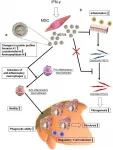(Press-News.org) Boston, MA (May 1, 2021) - Preliminary results of a clinical trial, presented today at the AATS 101st Annual Meeting, showed that a new, low-profile thoracic aortic endograft is safe and effective in the treatment of descending thoracic aortic aneurysm or penetrating atherosclerotic ulcer (PAU) diseases. A multi-disciplinary team, led by both cardiac and vascular surgeons as co-investigators, conducted the study in 36 centers in the United States and Japan, enrolling patients between 2016 and 2019.
The trial aimed to measure safety and efficacy of the RELAY®Pro endovascular device, a second-generation product featuring a dramatically reduced profile and a non-bare stent (NBS) configuration.
The prospective, international, non-blinded, non-randomized pivotal trial analyzed a primary safety endpoint of major adverse events (MAE) at 30 days (death, myocardial infarction, stroke, renal/respiratory failure, paralysis, bowel ischemia, procedural blood loss) and a primary effectiveness endpoint of treatment success at one year (technical success, patency, absence of aneurysm rupture, type I/III endoleaks, stent fractures, secondary interventions, aneurysm expansion, and migration). Treatment success at one year was 89.2 percent.
"With a 3 to 4 French profile reduction, this second generation thoracic endograft device met the one year safety and effectiveness endpoints in a pivotal study for the treatment of patients with aneurysms of the descending thoracic aorta or PAUs," explained Dr. Wilson Szeto, Professor of Surgery at the Hospital of the University of Pennsylvania and Penn Presbyterian Medical Center. "It is particularly positive to note that the reduction in profile and the availability of a non bare stents configuration will expand the population of patients who can be treated with the device and reduces complications."
In this study, the vast majority of patients in the United States were treated with a percutaneous approach, which can dramatically reduce surgical complications associated with higher profile devices requiring surgical cutdown for deployment. At one year follow up, patients demonstrated a low risk of mortality, endoleak or structural integrity concerns. Follow-up continues to five years and the device is currently being evaluated for approval by the FDA.
INFORMATION:
Notes for Editors:
"One Year Results of a Pivotal Study of a Second Generation Low-Profile Endograft in Subjects with Thoracic Aortic Aneurysm and Ulcer Pathologies," Wilson Y Szeto, Prashanth Vallabhajosyula, Hitoshi Matsuda, Sina Moainie, Mel Sharafuddin, Joel Corvera, Christopher Smolock, Shinji Miyamoto, Thomas Naslund, Venkatesh Ramaiah. University of Pennsylvania, Philadelphia, PA; Yale University, New Haven, CT; National Cerebral and Cardiovascular Center, Suita, Japan; St Vincent Heart Center, Indianapolis, IN University of Iowa, Iowa City, IA; Indiana University, Indianapolis, IN; Cleveland Clinic, Cleveland, OH; Oita University Hospital, Yufu, Oita, Japan; Vanderbilt University, Nashville, TN; Arizona Heart Institute, Phoenix, AZ
Presented by Wilson Y. Szeto, MD, May 1, 2021, at the AATS 101st Annual Meeting.
ABOUT THE AMERICAN ASSOCIATION FOR THORACIC SURGERY (AATS)
The American Association for Thoracic Surgery (AATS) is an international organization that encourages, promotes, and stimulates the scientific investigation of cardiothoracic surgery. Founded in 1917 by a respected group of the earliest pioneers in the field, its original mission was to "foster the evolution of an interest in surgery of the Thorax." Today, the AATS is the premiere association for cardiothoracic surgeons in the world and works to continually enhance the ability of cardiothoracic surgeons to provide the highest quality of patient care. Its more than 1,500 members have a proven record of distinction within the specialty and have made significant contributions to the care and treatment of cardiothoracic disease. Visit http://www.aats.org to learn more.
Boston, MA (May 1, 2021) - A new study presented today at the AATS 101st Annual Meeting, found that the percentage of patients undergoing esophagectomy for cancer who suffer Venous Thromboembolism (VTE) post-operatively is much higher than previously reported, with as many as 24 percent suffering from Deep Vein Thrombosis (DVT) or Pulmonary Embolism (PE). Six-month mortality for patients with VTE was 17.6 percent compared to 2.1 percent for those without.
Venous Thromboembolism (VTE) is a common, potentially preventable post-operative complication leading to significant morbidity and mortality. Esophagectomy patients are amongst the highest risk groups ...
Niigata, Japan--Researchers from Niigata University , the University of Tokyo, Osaka University and Tokyo Medical University, Japan have developed a new approach that could revolutionize the treatment, prevention, and possibly reversal of the damages caused by liver diseases. This novel strategy exploits small extracellular vesicles (sEVs) derived from interferon-γ (IFN-γ) pre-conditioned MSCs (γ-sEVs).
Cirrhosis and other chronic liver diseases remain a global health concern, with close to 2 million deaths reported annually, these account for approximately 3.5% of annual worldwide deaths. All these ...
Researchers from University of Arizona and University of Utah published a new paper in the Journal of Marketing that examines why most scholarly research is misinterpreted by the public or never escapes the ivory tower and suggests that such research gets lost in abstract, technical, and passive prose.
The study, forthcoming in the Journal of Marketing, is titled "Marketing Ideas: How to Write Research Articles that Readers Understand and Cite" and is authored by Nooshin L. Warren, Matthew Farmer, Tiany Gu, and Caleb Warren.
From developing vaccines to nudging people to eat less, scholars conduct research that could change the world, but most of their ideas either are misinterpreted by the public or never escape the ivory tower.
Why does most academic ...
Supporting female survivors of childhood maltreatment is critical to disrupting intergenerational abuse as new research from the University of South Australia shows a clear link between parents who have suffered abuse and the likelihood of their children suffering the same fate.
The finding amplifies an acute need for far better support for victims of child maltreatment to ensure safer and more nurturing environments for all children.
Funded by the NHMRC and the Channel 7 Children's Research Foundation, and published in The Lancet Public Health today, the study found that most child maltreatment is occurring among families caught up in intergenerational cycles of child abuse and neglect - 83 per cent of ...
Largest study so far of more than 17 million adults in England confirms that minority ethnic groups had a higher risk of testing positive, hospitalisation, admission to intensive care units (ICU), and death from COVID-19 compared with white groups, even after accounting for other factors known to increase risk like deprivation, occupation, household size and underlying health conditions.
Disparities for hospitalisation and death lessened for most minority ethnic groups between pandemic waves 1 (February to September 2020) and wave 2 (September to December 2020), but increased for South Asian groups.
To tackle ethnic disparities in COVID-19 risks, the authors call for reducing structural disadvantage and inequality, improving quality of and access to healthcare, and improving uptake ...
HOUSTON ? A Phase II trial led by researchers at The University of Texas MD Anderson Cancer Center found that BK virus (BKV)-specific T cells from healthy donors were safe and effective as an off-the-shelf therapy for BKV-associated hemorrhagic cystitis (BKV-HC), a painful complication common after allogeneic stem cell transplants for patients with leukemia or lymphoma. The study was published today in the Journal of Clinical Oncology.
Infusion of T cells targeting BKV resulted in rapid responses, with 67.7% of patients seeing a complete or partial improvement in symptoms after 14 days. This increased to 81.6% of patients after 28 days post-infusion. No cases of grade ...
The marine worm Ramisyllis multicaudata, which lives within the internal canals of a sponge, is one of only two such species possessing a branching body, with one head and multiple posterior ends. An international research team led by the Universities of Göttingen and Madrid is the first to describe the internal anatomy of this intriguing animal. The researchers discovered that the complex body of this worm spreads extensively in the canals of their host sponges. In addition, they describe the anatomical details and nervous system of its unusual reproductive ...
Scientists from several hospitals and research centers have shown what happens in individual cells of patients who died of COVID-19. In a study published in Nature, the researchers describe how infected cells from multiple organs exhibited a range of molecular and genomic changes. They also saw signs of multiple, unsuccessful attempts by the lungs to repair themselves in response to respiratory failure, which is the leading cause of death in COVID-19 patients.
"You really feel the tragedy of the disease when you see that result," said Aviv Regev, co-senior author of the study and a core institute member at the Broad Institute of MIT and Harvard when the study began. "The lung tries everything at its disposal, and it still can't fix itself. This was a very ...
HOUSTON - (April 30, 2021) - The microscopic structures and properties of materials are intimately linked, and customizing them is a challenge. Rice University engineers are determined to simplify the process through machine learning.
To that end, the Rice lab of materials scientist Ming Tang, in collaboration with physicist Fei Zhou at Lawrence Livermore National Laboratory, introduced a technique to predict the evolution of microstructures -- structural features between 10 nanometers and 100 microns -- in materials.
Their open-access paper in the Cell Press journal Patterns shows how neural networks ...
CHARLOTTESVILLE, Va. - In 2018, industry and academic researchers revealed a potentially devastating hardware flaw that made computers and other devices worldwide vulnerable to attack.
Researchers named the vulnerability END ...



